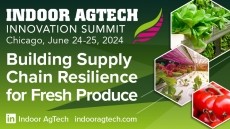New approach to cultivar selection needed to maximise lettuce production in greenhouse vertical farming

Greenhouse vertical farming under natural sunlight is an alternative farming technique that grows the crops in a stacking column and extends in a vertical direction. It has emerged as a promising solution to address the challenges posed by climate change and limited arable land. Unlike traditional farming methods, vertical farming optimizes space utilization and resource efficiency, making it ideal for urban areas and regions with limited land availability.
As such, it offers several advantages and disadvantages, especially in regions like Southeast Asia. The former include year-round production and climate control, which are especially useful in areas with unpredictable weather patterns, extreme temperatures and high humidity levels.
Additionally, greenhouse vertical farming allows for optimised land use (which is particularly advantageous in densely populated areas where available land may be limited), protection against pests and diseases, and water efficiency.
Conversely, however, maintaining optimal growing conditions can be energy-intensive and foster a reliance on external inputs like fertilisers and nutrients, thereby increasing production costs. This dependency on external inputs (especially those not sustainably sourced), alongside the production of greenhouse materials like plastics, can contribute to environmental degradation.
Moreover, with sunlight availability one of the crucial factors for crop development in greenhouse vertical farming, it is important to determine how it differs from level to level in order to optimise and maximise crop production.
Lettuce find the sun
Lettuce, a staple vegetable in Thailand, holds particular promise for vertical farming due to its compact growth habit and relatively short cultivation period. By utilising vertical space efficiently, farmers can significantly enhance lettuce production while conserving land and resources.
In a pioneering study, researchers at Chiang Mai University delved into the intricate relationship between sunlight availability and lettuce growth within vertical farming systems. The investigation, aimed to shed light on how varying levels of sunlight could impact the productivity and feasibility of lettuce cultivation in vertically stacked environments.
The team of agricultural scientists behind the study constructed six shelves with three levels each: upper, middle and lower. Lettuces of the 'Baby Cos' and 'Green Oak' varieties were planted at 14 days after sowing across the different levels. Sunlight intensity was measured using photosynthetic photon flux density (PPFD) and converted to daily light integral (DLI). Plant height, canopy width and fresh weight were assessed at various stages of growth.
Subsequently, the researchers found that the upper level exhibited the highest PPFD and DLI values, while sunlight intensity decreased progressively from the upper to lower levels. At the same time, shading from neighbouring shelves contributed to reduced sunlight availability in lower levels.
Despite higher sunlight intensity at the upper level, both lettuce varieties exhibited lower plant height, canopy width and fresh weight compared to the middle and lower levels. This suggested that optimal crop growth might not necessarily correlate with the highest light intensity.
Furthermore, light use efficiency (LUE) increased from the upper to lower levels, indicating that crops at lower levels utilized sunlight more effectively for growth and yield. Overall, vertical farming demonstrated superior crop yields and economic returns compared to horizontal farming, despite higher initial investment costs and water usage.
Future indicators for farming
These findings underscored the importance of strategic crop positioning and light management in vertical farming systems. By optimising shelf design, crop selection and cultivation techniques, growers can maximise productivity and economic efficiency in limited-space environments.
The study could pave the way for further research into optimising vertical farming techniques, including dynamic lighting systems and spectrum manipulation, to enhance crop performance and profitability. By harnessing the power of sunlight effectively, vertical farming could revolutionise agricultural practices and ensure food security in the face of climate change and urbanization.
As Thailand continues to face challenges associated with climate change and land scarcity, investments in ag-tech solutions like vertical farming are poised to play a pivotal role in securing food security and economic prosperity for future generations.
Moreover, the study's implications extend beyond lettuce production, offering valuable insights for Thailand's ag-tech industry. With further research and innovation, vertical farming has the potential to revolutionise agricultural practices, driving economic growth and sustainability in the region.
The researchers concluded: “These observations highlight the significance of crop selection and the optimisation of specific crop types for each level, based on light intensity considerations. It is crucial to select lettuce cultivars that can thrive under varying light conditions and align with the available light intensity on different levels of the vertical farming system.”
Source: National Center for Biotechnology Information
“Vertical farming for lettuce production in limited space: a case study in Northern Thailand”
https://doi.org/10.7717/peerj.17085
Authors: Suwimon Wicharuck, et al.
























